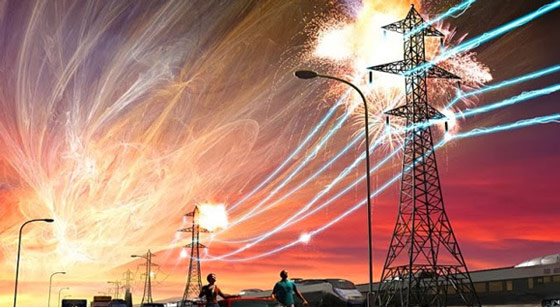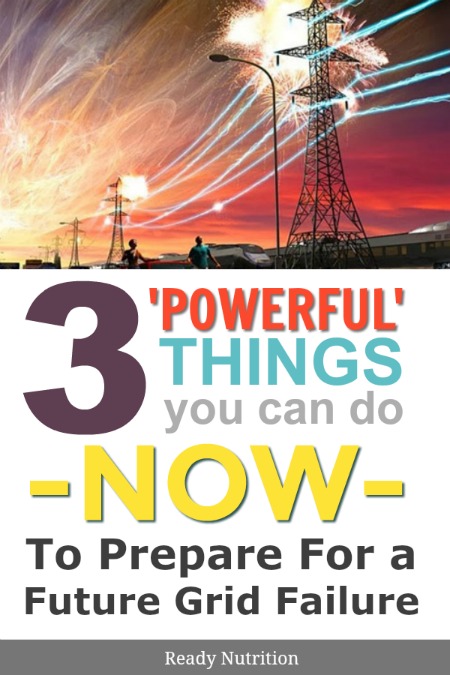
In the event of a grid failure, would you be prepared? Many who prep save extra food and water, but have no idea what actually going “off the grid” would entail. But there are some tips and tricks to preparing so you don’t find yourself or your family at the whims of those currently running the political system.
So what could happen in the event of a nation-wide power grid failure? If you rely on FEMA (Federal Emergency Management Agency), the situation could be dire. And what if it’s winter time? You will most likely be forced from your home in the dead of winter, with nothing more than the few supplies you were able to carry amongst yourselves. You would then be shuttered and locked into a community center (FEMA camp) with thousands of other families, displaced from their homes as well, relying on what few supplies the government could provide. You would have to wait in long lines to use the portable bathroom and security guards would monitor your every move. It wouldn’t exactly be a utopia – it would be more like a prison.
Living off the gird and staying out of those camps is your other option. Of course, that’s far from ideal as well, considering you will be without the basic modern amenities we’ve all come to rely on, but you’d have your freedom. If you choose to “bug in”and live off the grid in the event of a prolonged power grid failure, here are three”powerful” tips to help you survive and make the most of your supplies or gear.
Tip #1: Keep extra ammunition stored
This may seem like a no-brainer, but so many preppers seem more concerned about making sure their “fight skills” with their guns surpass the supply of ammunition they have on hand. Those skills are incredibly useful, however, absolutely worthless if you use up your ammunition on the first day of a grid failure. Keep thousands or even tens of thousands of extra rounds in your stored gear. Keep them safe and dry. The reason being is two-fold. When power fails, it causes utter and complete chaos for those not fortunate enough to have had the foresight to prepare. Of those left who don’t have any or only keep a few rounds on hand, they will use up their ammunition quickly trying to either protect themselves and the little food they have or hunting to attempt to kill something to eat. The grocery stores won’t be stocked when the power grid goes down so just where are the ill-prepared supposed to get any food? There also could be a run on properties such as yours where provisions have been made. In the event that you’ve saved a lot of ammunition, you’ll have plenty should you need to protect yourself and your family as well as the supply of food and water you’ve diligently stored for this exact SHTF scenario. You can also use ammunition to barter. Debit and credit cards will not work without the grid, and if someone doesn’t want your useless dollar or chunk of gold (which is unedible and only useful if someone wants it), a round of ammunition could be a viable currency. It could mean life or death for someone wanting it to hunt for meat or protect their own home and you could work out a trade for it.
Tip #2: Up Your Water Storage
Many of us have water stored, but most are not ready for a long-term grid failure in which a substantial dent will be made in that supply. You should find a renewable source of water. Rain barrels are one potential option, however, you will need to make sure that the capacity you are collecting is enough to last you from rain to rain. The great thing about rainwater collection is that the collection itself is virtually zero work once you have your system set up and it is possible to get an insane amount of water from the mildest of downpours. For every 1” of rain on a 1000 square feet of roof, you can collect around 600 gallons. If you have moderate rains, this could keep a family of 4 in water for a long time. This is the better option because if you have to go collect any water, threats to your life and the water you’ve just acquired could present themselves.
You will also need a filtration system for your water. This is the part of the water problem that will cause more illnesses to survivors in a SHTF situation. There are virtually no untainted sources of water unless you tap into a spring right as it is coming out of the ground or a well. If you have a well, consider rigging up a powerless well-pump. Here’s one inexpensive and easy option:
Tip #3: Provide SOME Power
If you still want to be off the grid but have the option to keep your home lit up, you could consider a wind turbine. Realistically, the perfect conditions for a windmill would be outside city limits so the sight of the windmill doesn’t offend those living near you or draw the attention of code enforcers. The further away from a town, the better, in fact. There are several different ways to approach wind power, and not all of them require the purchase of a costly windmill. Consider building one completely on your own. This article lists 15 different and a few very inexpensive options for harnessing the power of the wind in the event of a grid failure.
It won’t be a utopia if the grid goes down, that’s for certain, especially when considering the very vast majority of Americans don’t have basic survival skills nor do they seem interested in learning them. But using these three “powerful” tips will help you avoid the FEMA camps that would most likely pop up everywhere and allow you to remain free.
Preparing does not have to be costly or difficult, in fact, there are many resources out there to add further assistance. Consider reading The Prepper’s Blueprint by Tess Pennington for more concise instructions and a detailed guide to preparing for the worst.
“If we have learned one thing studying the history of disasters, it is this: those who are prepared have a better chance at survival than those who are not.” – Tess Pennington, The Prepper’s Blueprint

This article was originally published at Ready Nutrition™ on July 23rd, 2018








So glad you enjoyed the book! It’s good to have information on hand in an off-grid situation.